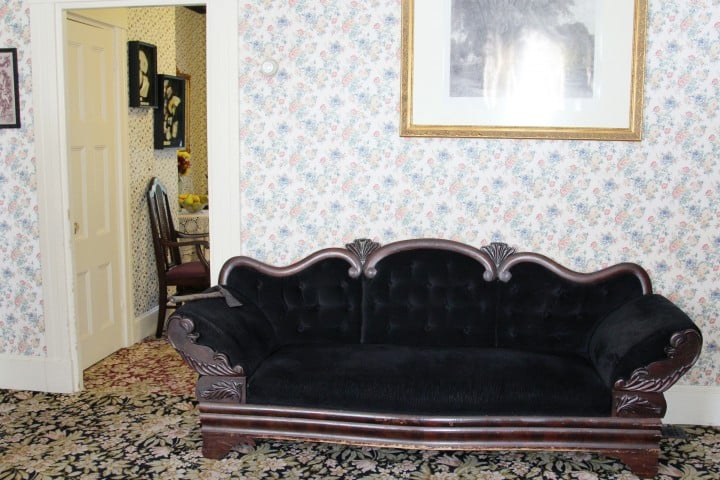Did Lizzie Borden Really Take an Ax and Give Her Mother 40 Whacks?
Yankee Classic: August 1992 Oak Grove Cemetery sits atop the hill city of Fall River, Massachusetts, like a stony crown. Inconspicuous in this diadem of the dead stands a granite obelisk marked BORDEN, but then there are a host of Bordens among the dead of Fall River. Surrounding the tall memorial stone, however, are low […]

Coffee By Design | Portland, Maine
Photo Credit : Katherine KeenanYankee Classic: August 1992
Oak Grove Cemetery sits atop the hill city of Fall River, Massachusetts, like a stony crown. Inconspicuous in this diadem of the dead stands a granite obelisk marked BORDEN, but then there are a host of Bordens among the dead of Fall River. Surrounding the tall memorial stone, however, are low stone markers designating individual graves. Upon one of them is the name LISBETH, and beneath this stone lie the remains of Fall River’s most infamous native — Lizzie Borden.
There are six bodies laid out in the Borden family plot — Lizzie, her sisters Emma and Alice, her mother Sarah, her father Andrew, and her stepmother Abby. Lizzie’s feet are at the heads of her father and stepmother or where their heads would be if someone hadn’t butchered them both with an ax on the scorching hot morning of Thursday, August 4, 1892.
Lizzie Borden was arrested and tried for these brutal murders, but popular history forgets that she was acquitted. The violent deaths of Andrew and Abby Borden remain unsolved, and a century after the bloody event, the Borden murders have passed out of the annals of crime into the realm of folklore. Buried here at Oak Grove is the dark heart of an American myth.
Fifty years ago Robert Flynn used to cut through Oak Grove Cemetery on his way to high school football games and stop by the unquiet Borden grave, wondering what really happened. The son and grandson of Irish-American textile workers who labored in the Fall River cotton mills, he was raised believing that Lizzie Borden had gotten away with murder. Indeed, the judgment on Lizzie tended to follow class lines with the Irish and Portuguese working people of the city convinced of her guilt, while the Yankee proprietors on the hill kept their own counsel.
“It was always very hush-hush,” says Flynn. “It was never talked about in school. Only in the last couple of years have things opened up a bit.”
And Flynn has been one of those who has helped open things up. Since retiring as an oil company executive, he has assembled one of the foremost collections of Bordeniana in the country, the arcane treasures of which are housed in the basement den of his Portland, Maine, home. He owns a scrapbook of the Borden case kept by a reporter who covered the trial in 1893 and a rare century-old first edition of Fall River Globe police reporter Edwin H. Porter’s The Fall River Tragedy.
Many believe that when Porter’s book came out, Lizzie Borden bought up all but a handful of copies. So rarely do copies appear that Flynn searched for ten years before finding one for $350 in 1985. Flynn then republished it in a facsimile edition under his own King Philip Publishing Company imprint, named for Flynn’s boyhood Fall River street.
Since reissuing the Porter book, Flynn has also reprinted a curious little 1893 monograph entitled The Mystery Unveiled and a 1941 treatise The Borden Murder Mystery: In Defense of Lizzie Borden by Arthur S. Phillips. Phillips was a member of Lizzie Borden’s defense team and the last living participant in the Borden trial.
For the Borden centennial, Flynn has used his own extensive collection to publish The Borden Murders: An Annotated Bibliography, a sourcebook listing 228 books, plays, films, recordings, operas, ballets, essays, and articles about the case. Here one finds the 1961 hit song, “You Can’t Chop Your Papa Up in Massachusetts,” by the Chad Mitchell Trio alongside Agnes De Mille’s 1948 Fall River Legend, a ballet that concluded with Lizzie being hanged.
“The distortion of the facts is just amazing,” says Flynn.
The undisputed facts in the Borden murders are few. Sometime between 9:00 and 11:15 on the morning of Thursday, August 4, 1892, Andrew J. Borden, 70, and his second wife, Abby D. Borden, 65, were brutally murdered in their modest house at 92 Second Street. The only other people in the house at the time were Lizzie, 32, and the Bordens’ maid, Bridget Sullivan, 25.
Andrew was found on his back on the couch in the first floor sitting room with his face and head mutilated. Abby was found facedown beside a bed in an upstairs guest room. She, too, had been savagely beaten about the head with an ax. “Lizzie Borden took an ax,” the ditty goes, “and gave her mother 40 whacks. And when she saw what she had done, she gave her father 41.” In fact, Lizzie’s stepmother was struck perhaps 20 times, while her father was struck just ten times.
Eight days after the murders, Lizzie Borden was arrested, and in June 1893 she stood trial in neighboring New Bedford. The trial was a 19th-century media circus. Through it all, Lizzie sat stoically, registering little or no response to the proceedings except upon two occasions.
At one point, following the prosecution’s two-hour rendition of the events of August 4, Lizzie, with all the decorum of a proper Victorian lady, quietly covered her face with her fan and fainted. Later, when the medical examiner, who had taken it upon himself to decapitate Mr. and Mrs. Borden, placed Andrew Borden’s grinning skull in evidence, Lizzie was politely permitted to leave the courtroom.
Following 13 days of testimony, Lizzie ‘s case went to the jury, which needed only an hour to acquit her. The evidence had all been circumstantial and the motive, somehow, too cold-blooded to support a crime of such passion. Would a dutiful daughter really slaughter her father and stepmother just to get at the old man’s money?
Andrew Borden, one of Fall River’s wealthiest citizens, was something of a skin flint. He owned a great deal of real estate, as well as interests in several banks and textile mills, but he and his family lived conspicuously below their means. Some accounts of the murders suggest that when Lizzie was served week-old mutton stew on the hottest day of the year, she could no longer stand her father’s parsimony and snapped. Regardless of who killed Andrew Borden, his death left his daughters independently wealthy. Lizzie soon purchased a mansion on the fashionable Highlands or “on the hill,” as they say in Fall River. Maplecroft (as the house was called) was an address more in keeping with her station in life, and Lizzie continued to live there until her death in 1927.
“Lizzie was in the upper strata of society,” says Bernie Sullivan. “Even though Andrew never moved up on the hill, I think they all responded and protected Lizzie during the trial.”
Sullivan, a soft-spoken gentleman with a trim white beard, is the editor of the Fall River Herald News and one of the city’s resident Borden experts. A Fall River native, his serious interest in the case was sparked 15 years ago when he purchased an old house that had once belonged to one of Lizzie Borden’s cousins. The previous owner had discovered an old ax hidden in the studding of the barn, and it pleased Sullivan to think that the ax (now one of his prized possessions) might be the actual murder weapon, perhaps having been given by Lizzie to her cousin to dispose of.
“I can’t prove it is the murder weapon,” says Sullivan with a smile, “but then again no one can prove that it isn’t.”
The ax presented at the trial as the murder weapon is actually a broken-handled hatchet. Found in the basement of the Borden house, it is a featured exhibit at the Fall River Historical Society, a great granite pile up on the Highlands.
Fall River, a city of 87,000 souls, has been slow to exploit the enduring public interest in the Borden murders. There is a Borden display at the historical society and at Lizzie’s, a popular tavern, but no Lizzie Borden museum or shrine. A decade ago, an out-of-town promoter proposed turning Maplecroft into a Borden museum, but despite promises to make it tasteful, the plan was not popular with Fall Riverites.
“I challenge anyone to make a double homicide decorous,” says Bernie Sullivan. Sullivan does not believe the good people of Fall River have a hang-up about the Borden murders, but Sullivan’s friend and fellow Borden buff Jules Ryckebusch disagrees. “It’s tough to admit that your most famous citizen is an ax murderess,” says Ryckebusch.
A hale fellow who sports a poet’s rumpled tweeds and unkempt beard, Ryckebusch got hooked on Lizzie after arriving in Fall River in 1966 to teach writing at Bristol Community College. His students frequently wrote about the case, often adding personal anecdotes acquired from friends and family. One student even gave Ryckebusch photographs of the Bordens’ bodies printed from the original 1892 police department negatives.
Ryckebusch’s fascination with the bizarre event led him to organize Fall River’s major observation of the Borden centennial, an academic conference this month at Bristol Community College. Even before the registration forms were printed, word of it had spread through the informal network of Bordenites, and Ryckebusch had 1,000 requests to fill.
“It’s the most famous murder in American history,” he says. “It received tremendous publicity at the time, of course, but it’s also because she was a woman. If Lizzie Borden had been a man, no one would be interested today.”
This interest in Lizzie Borden, however, presents a problem for Ron Evans, proprietor of C. J. Leary & Sons, Inc., on Second Street, a printing company that owns the house where the murders took place. The house now serves as a personal residence for the owners.
The exterior of the house looks much the same as it did a century ago, but what most contemporary photographs of it do not show is that the 19th-century neighborhood it was once part of is gone, replaced by a bus depot, a shopping mall, a parking garage, and an apartment complex. Still, everyone from curiosity seekers to scholars show up at the house on Second Street. Evans politely declines all requests for a peek inside. He even refused to allow Jules Ryckebusch to videotape the interior of the house to show at the Borden conference.
“It’s a private residence,” explains Evans with a practiced air of finality.
Evans’s lack of interest in showing off the Borden house does not mean he is not interested in the Borden case, however. And for the record, the man who owns the scene of the crime figures Lizzie did it. “If you’d ever been in the house,” says Evans, “you’d see that it’s so small you can hear everything being said in the other rooms.” He simply cannot believe that Lizzie could have been in the house while someone else was murdering her father and stepmother without hearing something. And Evans’s opinion accords with that of most Borden scholars.
“The general feeling among all of us who have studied the case,” says bibliophile Robert Flynn, “is that she was probably guilty.”
To hold this view, however, one must believe that a person is capable of a single outburst of homicidal mania in an otherwise blameless life. The chilling idea that Lizzie Borden, a Sunday school teacher, could suddenly turn on her elders with such fury and then go on to live a respectable, if somewhat reclusive life, is probably the single most fascinating aspect of the whole Borden myth.
However, as evidence of her murderous intent, Borden cognoscenti point out that Lizzie tried unsuccessfully to purchase poisonous prussic acid at a drugstore just prior to the killings — evidence not admitted at the trial.
Most books about the murders conclude that Lizzie was guilty. However, in 1961 Edward Radin’s Lizzie Borden, The Untold Story attempted to prove that Bridget the maid, motivated by the Bordens’ anti-Irish bigotry, was the culprit. The best book on the crime is probably Lizzie Borden: A Case Book of Family and Crime in the 1890s. Edited by Joyce Williams and published in 1980, the casebook presents all the known facts without drawing any final conclusions.
Fittingly in this centennial year, however, there is a major new addition to the Borden bibliography, and it does pretend to be the last word. And Lizzie Borden: The Legend, the Truth, the Final Chapter by Arnold Brown has the Borden establishment all shook up.
“I was brought up to believe two things about Lizzie Borden,” says Brown, another Fall River native who retired to Florida. “She was guilty and the trial was fixed.”
Brown, whose father worked in a fish market just two blocks from the Borden house, maintained a boyhood interest in the murders into adulthood, but a casual conversation in 1988 led to his sustained investigation of the case. Lewis Peterson, a fellow Fall Riverite in Florida, told Brown that his father-in-law had told him that the real murderer was a man named William S. Borden. William, argues Brown, was Andrew Borden’s illegitimate and probably insane son. As Brown sees it, Lizzie, her attorney, the police, the prosecution, and the three judges were involved in a conspiracy and cover-up to save the good name of Andrew J. Borden and to leave the social fabric of Fall River unsullied.
Lizzie’s lawyer, Brown points out, was former Massachusetts governor George Robinson, and one of the three judges at the trial was a Robinson appointee. One of the clinchers as far as Brown is concerned is that Governor Robinson was paid the whopping sum of $25,000 for defending Lizzie.
“What do you think he did with all that money?” asks Arnold Brown. “How far do you think he had to spread it?”
Most Borden buffs regard Lizzie Borden: The Legend, the Truth, the Final Chapter as just a fascinating piece of fiction. In reviewing Brown’s book for “The Fall River Historical Society Quarterly Report,” Fall River attorney John C. Corrigan Jr. writes that it is “long on legend, short on the truth, and not destined to be the final chapter at all.”
In his defense, Arnold Brown argues that “I have set up a premise of what could have happened.”
The fact that Brown’s conspiracy theory has few adherents among Borden regulars led him to threaten to boycott the Borden conference. “That conference,” says Brown, “will be 66 percent sideshow acts, 33 percent freaks and crazies, and one percent search for the truth.”
Most studies of the Borden murders have used a combination of circumstantial evidence, testimony, rumor, and reason in an attempt to find truth, but James Starrs, a professor of forensic sciences at George Washington University, has been trying to bring the cold, hard light of scientific inquiry to bear on the crime.
Starrs wants to find the skulls of Andrew and Abby Borden so he can take impressions of the wounds to see if they match the hatchet blade at the Fall River Historical Society.
“My hypothesis,” he says, “is that she really was innocent.”
In February, Starrs hired a geophysicist to survey the Borden grave with subsurface radar in hopes of determining whether the murder victims’ disarticulated skulls were interred with their bodies. The radar profile revealed that the grave sites had been disturbed, but Starrs could not tell whether the disturbances were the result of digging a second grave to bury the skulls or were just depressions caused by the coffins collapsing and the earth settling.
There is an element of grandstanding to his high-tech detective work in this Borden centennial year. The professor says he thought that undertaking his investigation in 1992 would make it easier for him to get access to Borden materials, but he is now having second thoughts, having run into what he terms “irrationality run amok” in Massachusetts.
It seems that far from welcoming Starrs’s scientific sleuthing, some folks around Fall River would prefer he let the Bordens rest in peace. Many people have written to object to his requests to disinter the Bordens’ remains.
What the good professor may be up against in Fall River is a fundamental human truth that folks like him and Arnold Brown fail to fully appreciate. It may be the only truth anyone really needs to understand about the Borden murder mystery.
“We don’t want anybody to solve the mystery,” explains Bernie Sullivan. “Then all the fun would be gone.”
Lizzie Borden’s Greatest Hits
The unsolved murders of Andrew and Abby Borden have inspired more than 200 books, articles, songs, poems, plays, a movie, an opera, and a ballet. Among the strangest and most notable:
“Lizzie Borden, a Family Portrait in Three Acts,” composed by Jack Beeson; libretto by Kenward Elmslie; scenario by Richard Plant. Premiere March 25, 1965, by New York City Opera.
“The theory of Lizzie Borden,” by Alexander Woolcott, Vanity Fair, September 29, 1927. The influential New York writer and critic was fascinated by Lizzie Borden, whom he called “America’s most interesting woman.” He once suggested to Borden Milk Company officials that their trademark cow be named Lizzie.
Miss Lizzie by Walter Satterthwait (St. Martin’s Press, 1989). In this fiction, set in 1921, Lizzie is suspected of the ax murder of a neighbor, but turns detective and manages to discover the identity of the real killer.
Fall River Legend — A Ballet by Agnes deMille, music by Morton Gould. Premiere April 22, 1948, by the Metropolitan Opera, New York.
The Legend of Lizzie Borden, George LeMaire Productions in association with Paramount Pictures, 1974. In this made-for-TV movie, Elizabeth Montgomery (formerly Samantha in Bewitched) played Lizzie.
‘You Can’t Chop Your Papa Up in Massachusetts,” music and lyrics by Michael Brown. First performed in the musical New Faces of 1952, later performed by the Chad Mitchell Trio on its album “Mighty Day on Campus” (Kapp Records).








You can visit the Lizzie Borden House. It is a bed and breakfast now, and a really fun tour.
Here’s the link to the Lizzie Borden B&B.
http://lizzie-borden.com/
Did the tour and stayed .loved it . Do not believe Lizzy did it. I think the maid killed them.